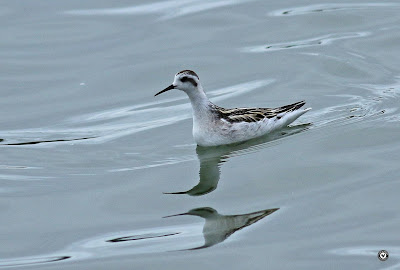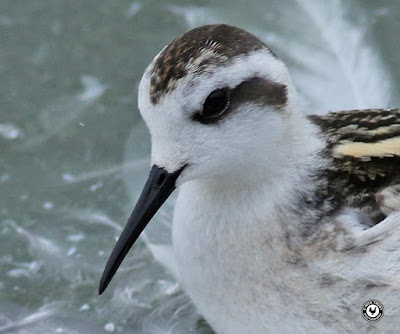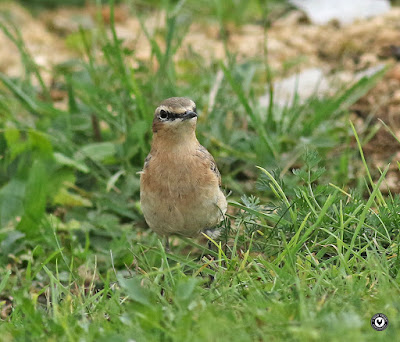We were greeted at the gate to the carpark by a chap in a high vis jacket which was a new one on us! After being asked if we were sailors or anglers and replying neither we're birders, we got the usual puzzled look and asked to park on the edge away from the main car parking area because there was a big sailing event on. Wouldn't be too much disturbance for the birds then? Not! But we needn't have worried since once up at the reservoir level we could see a group of maybe 15 or so birders on the causeway with scopes and cameras aimed at the shore of F2 and presumably the phalarope. For such a diminutive bird it was certainly drawing in plenty of admirers. We marched briskly along, noticing an influx of pied wagtails feeding along the reservoir edge, and joined the mini throng. Despite its minuscule size the red-necked phalarope was easy to see since it fed just a few metres out from the concrete edge. I settled in and allowed the bird to approach closely whilst I rattled off frame after frame. All photos were from above though now that the water level had been dropped by about 2 metres recently. The dunlin sized bird actively fed in shallow water, only occasionally venturing further out to snare a titbit. It never once came onto the shore (unlike the grey phalarope at Banbury) instead satisfying itself with the tiny flies and gnats on the reservoir surface.
We stayed with the phalarope for around half an hour but then moved on in search for the greater scaup. The scaup is primarily a sea duck only normally visiting the UK in winter and mainly on coasts in the north and east. So for one to turn up on an inland waterbody in autumn was an unusual record and very scarce for Oxfordshire. The bird had been frequenting the south west corner of F2 so we began our traverse of the larger basin towards that corner. I made sure to scrutinise every tufted duck that I came across just in case the scaup was lurking with them. No luck though and when we came across a fellow Oxon birder (and the ducks finder) we were informed that it had been present until, the dreaded, five minutes ago when it had been spooked by a fishing boat and flown towards the north west side! We tracked around, again searching the rafts of tufted ducks, but once again to no avail. It seemed as though the scaup had eluded us. Later in the morning we also walked the entire circuit of F1 to see if the duck had resettled there but there was not sign of it there either, Indeed as I write, the scaup has not been seen subsequently. Another one that got away, so close and yet so far! The walk though was not without reward. On F2 we spotted a strange coot which had many white feathers on its body whilst still retaining its jet black head, a very interesting looking individual.
 |
| partially leucistic coot |
 |
| not a scup, just another tufty! |
A very poorly looking grey black-backed gull rested on the concrete edge only swimming out onto the water when people approached too closely. Apparently this bird had been involved in scrap with another and came off worse for wear. Hopefully it' will survive.
 |
| poorly great black-backed gull |
 |
| chiffchaff |
 |
| goldcrest |
 |
| long-tailed tit |
The cafe was inundated with parents of the junior sailors taking part in a competition so we decided to scan F1 for the scaup and then after spotting several rafts of tufted ducks walked around to check them out, fruitlessly of course. We came upon a common sandpiper which never allowed close approach as usual here but had much better views of a lone dunlin which fed along the edge well away from the regatta. A couple of grey wagtails joined it for the peace and tranquility.
 |
| furtive common sandpiper |
 |
| confiding dunlin |
The hundreds of tufted ducks were just that so after another brief look at the red-necked phalarope which was still attracting admirers we headed back to the car.
I spotted the last remaining juvenile shag fishing by the water tower on F1 but rued the fact that it was too far away for any decent photos.
This time we managed to find room to be able to sit outside the cafe and enjoy a hot chocolate, a sure sign that it's getting colder! As we neared the car and passed the water tower on F2 the shag flew into the small bay there and settled just 50 metres or so away. I couldn't believe my luck and finally got my shots of a swimming bird. I say finally since when I saw the 11 juvenile shags after they had just arrived a month ago, I never managed even one picture of any of them in the water!
 |
| juvenile shag |
So all in all a pretty good day at the reservoir with some good birds seen but a shame that it was scaupless!












































